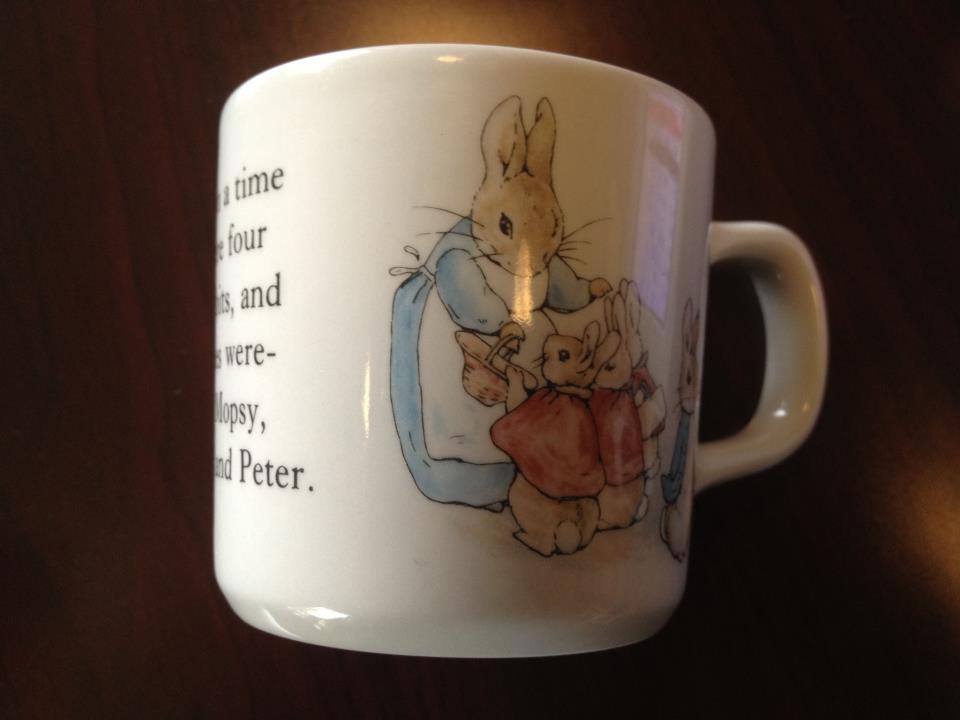Beatrix Potter 2007 Wedgwood China Peter Rabbit Baby Cup: 36,000 ppm Lead (90 ppm is unsafe for kids)
Beatrix Potter 2007
Wedgwood China
Peter Rabbit Baby cup
This little Beatrix Potter Peter Rabbit Wedgwood China baby cup was purchased new in about 2007 and was tested with an XRF instrument (by me) in 2012. This cup belonged to my friend Chelsea. As with most of these Beatrix Potter cups produced by Wedgwood before the new/ modern product safety regulations became enforceable, this one was predictably positive for a very high level of Lead, even though it is relatively new (not a vintage item by any means)!
How much Lead is too much Lead?
The Lead level on this item was 36,000 ppm. Thirty six thousand parts per million Lead! The amount of Lead considered toxic in a newly manufactured item intended for use by children (since the Consumer Product Safety Improvement Act of 2008 became enforceable) is anything 90 ppm Lead or higher in the paint, glaze, or coating and anything 100 ppm Lead or higher in the substrate.
Click the links below to see more examples:
- 1960 Peter Rabbit Wedgwood China Baby cup: 59,200 ppm Lead
- 1970 Peter Rabbit Wedgwood China Baby Bowl: 59,300 ppm Lead
- 1991 Peter Rabbit Wedgwood China Baby Dishes set: 52,000 ppm Lead
Are the new Beatrix Potter cups safe?
The brand new cups from this line are (appropriately, and in compliance with the new CPSC legislation) Lead-free. Any items from these sets made before 2010 (and even before 2012) should not be used for food use purposes and especially should not be used by children. Frankly, they should be disposed of!
As always, if you have any questions, please let me know!
For a Lead-free, modern version of this china, click here.*
Thank you for reading and for sharing our work!
Tamara Rubin
#LeadSafeMama
Chip-in to support Lead Safe Mama’s independent consumer good testing here.
*Some links on this page may be Amazon affiliate links. If you purchase something after clicking on one of these links, Lead Safe Mama, LLC may receive a small percentage of what you spend at no extra cost to you.
For those new to this website:
Tamara Rubin is a multiple-federal-award-winning independent advocate for childhood Lead poisoning prevention and consumer goods safety, and a documentary filmmaker. She is also a mother of Lead-poisoned children (two of her sons were acutely Lead-poisoned in 2005). Since 2009, Tamara has been using XRF technology (a scientific method used by the U.S. Consumer Product Safety Commission) to test consumer goods for toxicants (specifically heavy metals — including Lead, Cadmium, Mercury, Antimony, and Arsenic). All test results reported on this website are science-based, accurate, and replicable. Items are tested multiple times to confirm the test results for each component tested. Tamara’s work was featured in Consumer Reports Magazine in February of 2023 (March 2023 print edition).
Never Miss an Important Article Again!
Join our Email List










I have one of these. Is there a way to tell what year it is from? It doesn’t seem to say anywhere on it.
Hi Amanda,
Thank you for commenting. You can sometimes get a sense of the year by the style and shape of the cup and specifics of the design. I have several from different decades up on the blog that you can compare it to. Basically, in the absence of testing, I would consider any one of these from pre-2011 unsafe.
Tamara
Hi, This is interesting because I have had my Beatrix Potter dish wear (not new) tested and your results are very different. We’re the pieces you tested broken to text or was a surface test done? Thank you.
*were, *test
This is very interesting. Would it be possible that the high lead content was found only at the decoration area? If the test was done at the other areas, the high lead was not found. And thus if there is no decoration comes into contact with food, it should be safe to use?
The lead on these is in the clear glaze that coats the entire cup.
Wow! That was going to be my question as well. Not only is this amazing, but it is a shocking, nefarious, action committed by many manufacturers…